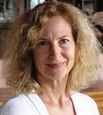How we look is so important in this culture. How we look becomes how we see ourselves. The image in the mirror seems like who we are. We carry that image around with us inside our heads, and when we think of me, we think of that image. We have many self-images, and our inner image of what we look like is perhaps the strongest. We are most identified with that self-image because identification with the body is so strong and because the mind needs something to pin the idea of me on.
Our inner picture of ourselves strengthens and holds in place the idea of me. Without that inner image, the idea of me weakens and can’t be maintained as easily. You may have experienced this when you were away from mirrors for a while, like when you were camping or in a more primitive living situation. You begin to experience yourself more as you really are than as an image you hold in your mind of yourself.
There’s a big difference between the experience of ourselves and the experience of an image of ourselves. The image is an idea. An image of ourselves is flat, un-alive, and we have to work hard to maintain it (especially without mirrors to help us), while the experience of ourselves is mysterious and ever-present. The experience of who we really are is just there. We don’t have to work at producing it; we just have to notice it.
Who we really are is experienced as what is looking out of our eyes. This is very mysterious: What is it that is looking out of your eyes? Take a moment and notice what it’s like to look out of your eyes and experience yourself that way. What a different experience it is from imagining what you look like in your mind’s eye.
When we experience ourselves looking out of our eyes, we experience our body very differently than when we imagine our body or when we see it in a mirror. Stop a moment and just look at the miracle that is your body, without any comments or thoughts about it. What do you experience? You are likely to experience the body as something apart from yourself, something you look upon with amazement. Whose hand is that? Whose leg is that? The body appears to be more of a vehicle for who you are than who you are. And so it is. The body is a vehicle for who we really are. The mind pretends that vehicle is who we are, but the body is only a temporary carrier for the consciousness that is looking out of our eyes.
Through the formation of an inner image, the mind takes us away from the reality that we are not the body. That inner image is made possible by mirrors and other reflective surfaces. Without them, we wouldn’t know what our body looked like. We would experience ourselves without having an inner image of ourselves. The mind would still form other self-images, perhaps a made-up image based on how people react to us. Identifying with an image of ourselves would be much harder if an image of ourselves wasn’t constantly being reinforced by mirrors.
To begin to live more from the real experience of ourselves rather than from an image of ourselves, we don’t have to get rid of mirrors, although living without them for a while can be helpful. We can just realize we are not the body and consciously choose to put our attention on what is looking out of our eyes rather than on what we think other people see when they look at us.
Noticing what is looking out of our eyes results in a dramatically different experience of ourselves, and it allows us to be much more present to life. Maintaining a self-image is hard work, and it interferes with being present to whatever else is going on. When we give our attention to our self-images and thoughts, we miss so much else that is going on. The ego overlooks and discounts much of what is happening and assumes nothing is happening. It tries to draw us out of the moment and into thinking. It doesn’t give life a chance to reveal its richness. When we give our full attention to life instead of to our thoughts, we discover the happiness and contentment we’ve always wanted but haven’t been able to find in the ego’s world. Ideas just can’t substitute for real life.
From Embracing the Now: Finding Peace and Happiness in What Is by Gina Lake.
Copyright © 2008 Gina Lake. All rights reserved.
Gina Lake is a spiritual teacher who is devoted to helping others wake up and live in the moment through her books, counseling, and intensives. She has a master's degree in counseling psychology and over twenty years experience supporting people in their spiritual growth. Her books include Loving in the Moment, Radical Happiness, Embracing the Now, Anatomy of Desire, Return to Essence, What About Now? Living in the Now, and Getting Free. Her website offers information about her books and consultations, free e-books, book excerpts, a free monthly newsletter, a blog, and audio and video recordings: http://www.radicalhappiness.com.

Post new comment
Please Register or Login to post new comment.